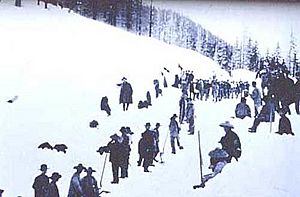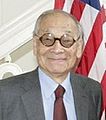Chinese American facts for kids
| Total population | |
|---|---|
| (3,794,673 1.2% of the U.S. population (2010)) |
|
| Regions with significant populations | |
| New York City, San Francisco, Los Angeles, Dallas-Fort Worth, Houston, Boston, Washington D.C., Chicago, Philadelphia, Seattle | |
| Languages | |
| Predominantly English, varieties of Chinese: Mandarin Chinese (Standard Chinese), Yue Chinese (Cantonese, Taishanese), Min Chinese (Min Dong, Min Nan), Hakka, Wu Chinese (Taihu Wu, Oujiang Wu), and Minority Uyghur. |
|
| Religion | |
| Unaffiliated, Protestantism, Buddhism, Catholicism | |
| Related ethnic groups | |
| Hong Kong Americans, Taiwanese Americans Overseas Chinese |
| Chinese American | |||||||||||
|---|---|---|---|---|---|---|---|---|---|---|---|
| Traditional Chinese | 華裔美國人 | ||||||||||
| Simplified Chinese | 华裔美国人 | ||||||||||
|
|||||||||||
| Alternative Chinese name | |||||||||||
| Traditional Chinese | 美籍華人 | ||||||||||
| Simplified Chinese | 美籍华人 | ||||||||||
|
|||||||||||
| This article contains Chinese text. Without the correct software, you may see question marks, boxes, or other symbols instead of Chinese characters. |
Chinese Americans are people living in the United States who have Chinese family roots. They are part of a larger group called Overseas Chinese, which means Chinese people living outside China. They are also a subgroup of East Asian Americans.
The first Chinese immigrants came to the U.S. in 1820. Before the 1848 California Gold Rush, fewer than 1,000 Chinese people had arrived. The Gold Rush brought many Chinese workers to America. They often did difficult jobs for the gold miners.
Chinese people were some of the earliest immigrants to the U.S. However, a law called the Chinese Exclusion Act stopped most Chinese immigration between 1885 and 1943. After this law was removed, immigration was still very limited until 1965.
Contents
Exploring Chinese American History

Many Chinese people have immigrated to the United States over time. Like other immigrant groups in America, Chinese immigrants have faced both challenges and achieved great successes.
Understanding Citizenship for Chinese Americans
All ethnic Chinese people born in the United States are American citizens. This is because of the Fourteenth Amendment and a Supreme Court decision in 1898.
When immigrants become U.S. citizens, they promise loyalty to the United States. They do not have to officially give up their old citizenship. However, the People's Republic of China does not allow dual citizenship. This means they see becoming an American citizen as giving up Chinese citizenship.
Major Contributions by Chinese Americans

Chinese Americans have made many important contributions to the U.S. These include:
- Building the western part of the Transcontinental railroad.
- Building walls (levees) in the Sacramento River Delta to control water.
- Helping to develop and farm much of the land in the Western U.S..
- Bringing Chinese food to America, which led to American Chinese cuisine.
- Making new technological developments, especially in the Bay Area.
In earlier times, most Chinese immigrants came from the Guangdong (Canton) area and later Hong Kong. More recently, many Chinese people from mainland China have arrived for skilled jobs. Many of these Chinese Americans have high educational degrees and value learning.
Language and Culture
Chinese is the third most-spoken language in the United States. Most people who speak Chinese in the U.S. are Chinese Americans or their descendants. It is especially common in California. Over 2 million Americans speak some form of Chinese.
Even though Chinese Americans grow up speaking English, some teach their children Chinese. They do this for different reasons, such as pride in their family's culture and history.
Notable Chinese Americans
- See List of Chinese Americans.
Images for kids
-
Chinese-American miners in the Colorado School of Mines' Edgar Experimental Mine near Idaho Springs, Colorado, c. 1920
-
New York City has the largest Chinese American population of any city, with over 600,000 people as of 2017. Large Chinatowns in Manhattan, Brooklyn (above), and Queens are busy cultural centers. This is because many Chinese immigrants continue to arrive in New York. The New York metropolitan area has the largest Chinese population outside Asia, with about 893,697 people as of 2017.
-
San Francisco has the second largest Chinese community in the United States by number. It has the largest percentage of Chinese people compared to its total population.
-
Technology companies like eBay in places like California's Silicon Valley offer many jobs. They attract Chinese Americans and Chinese entrepreneurs from other countries.
-
I.M. Pei was a famous architect. He designed the pyramid at the Louvre museum and the Rock and Roll Hall of Fame museum.
See also
 In Spanish: Sinoestadounidense para niños
In Spanish: Sinoestadounidense para niños







